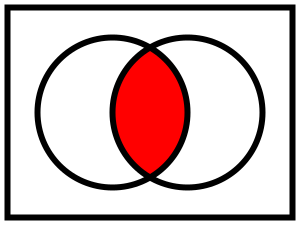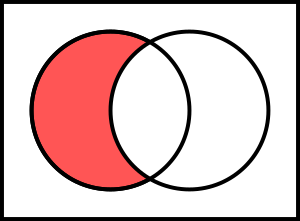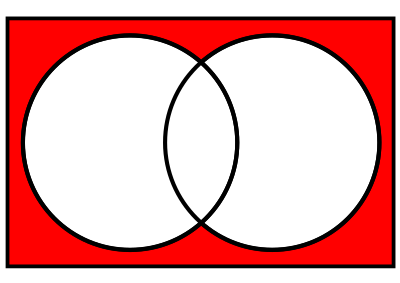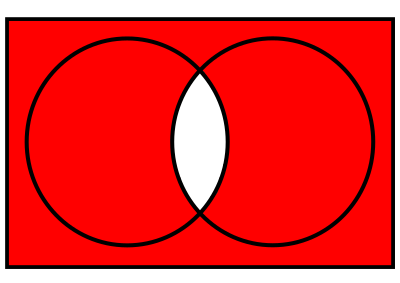잔글 (→논리 연산) |
Senior9324 (토론 | 기여) 잔글 (Senior9324 사용자가 수포자도 쉽게 알 수 있는 수학/집합과 명제 문서를 시리즈:수포자도 쉽게 알 수 있는 수학/집합과 명제 문서로 옮겼습니다) |
(차이 없음)
| |
2015년 12월 4일 (금) 00:19 판
집합
일단 집합이 쉬운 개념은 아니라는 것부터 인식할 필요가 있다. 중학교 1학년 첫단원이라서 그런가, 다들 그다지 어렵게 생각 안해서 그렇지 집합이란 사실 대단히 추상적인 개념으로, 대단히 최근에(예를 들어 미적분보다 더 요즘) 생겨난 개념이다. 만일 이 단원이 어렵지 않게 느껴진다면 이미 수학적 사고와 추상화에 대단히 익숙해져 있기 때문이다. 거기에 익숙하지 않은 사람들은 당연히 이 단원이 어렵다!
집합은 결국 수학적 엄밀성과 연결되어 있다. 칸토어가 수학적 엄밀성을 추구하다보니 집합이란 개념이 생각난 것이고, 이는 1960년대의 새수학 운동과도 연결되어 있으므로, 이 단원을 언제 가르쳐야 할지 현재 애매한 상태이다. 현재는 수학II 교과에서 가르친다.
간단히 말해서, 집합이란 건 모임이다. 우리 가족의 모임을 예로 들면 울아빠, 울엄마, 나, 우리동생 이렇게 표현할 수 있는 것처럼 이를 기호로 우리 가족={울아빠, 울엄마, 나, 우리동생} 이렇게 표현한 것이다. 그런데, 유의할 점이, 집합 안에도 원소로 집합이 들어갈 수 있다는 점이다. 예를 들면, 추석 때 모이는 친족 모임={우리 가족, 큰아버지 가족, 작은아버지 가족} 이런 방식으로 가족이라는 집합을 원소로 또 다른 집합을 만들 수 있는 것이다. 여기서 헷갈리지?
- 공집합: 원소가 하나도 없는 집합. 기호는 [math]\displaystyle{ \{ \} }[/math]나 [math]\displaystyle{ \emptyset }[/math].
[math]\displaystyle{ \phi }[/math]와는 다르다 [math]\displaystyle{ \phi }[/math]와는공집합은 모든 집합의 부분집합이다. - 전체집합: 고려해야하는 모든 대상을 담은 집합. 기호로는 보통 [math]\displaystyle{ U }[/math](universal set)를 쓴다.
집합 원소의 개수
A가 유한집합일 때, A의 원소의 개수를 [math]\displaystyle{ n(A) }[/math]로 표기한다. 나중에는 [math]\displaystyle{ |A| }[/math]의 표기도 쓴다.
집합의 연산
합집합
A에 속하거나 B에 속하는 모든 원소로 이루어진 집합을 A와 B의 합집합(union)이라고 하며 [math]\displaystyle{ A \cup B }[/math]로 표현한다.
여집합은 논리 연산자 OR([math]\displaystyle{ \lor }[/math])과 연관된다. 즉, [math]\displaystyle{ x \in A \cup B \iff x \in A \lor x \in B }[/math]이다.
교집합
A와 B에 동시에 속하는 원소로 이루어진 집합을 A와 B의 교집합(intersection)이라고 하며 [math]\displaystyle{ A \cap B }[/math]로 표기한다.
교집합은 논리 연산자 AND([math]\displaystyle{ \land }[/math])와 연관된다. 즉, [math]\displaystyle{ x \in A \cap B \iff x \in A \land x \in B }[/math]이다.
[math]\displaystyle{ A \cap B = \emptyset }[/math]이면 A와 B는 서로 소(disjoint)라고 한다. 반대로 [math]\displaystyle{ A \cap B \neq \emptyset }[/math]이면 A와 B는 intersect한다고 하는데, 우리말로는 적당한 번역어가 없다.
여집합
전체집합 U의 원소 중에서 A에 속하지 않는 모든 원소로 이루어진 집합을 (U에 대한) A의 여집합(complement)이라고 하고, [math]\displaystyle{ A^{c} }[/math]로 표기한다. 달리 표현하면 [math]\displaystyle{ A^{c} = U - A }[/math]이다.
여집합은 논리 연산자 NOT([math]\displaystyle{ \neg }[/math], 고등학교에서는 [math]\displaystyle{ \sim }[/math]를 더 많이 쓴다)과 연관된다. 즉, [math]\displaystyle{ x \in A^{c} \iff \neg[x \in A] }[/math]이다.
차집합
집합 A의 원소 중 집합 B의 원소가 아닌 것의 집합을 A에서 B를 뺀 차집합(difference)이라고 하며, [math]\displaystyle{ A-B }[/math]로 표기한다. 나중에는 [math]\displaystyle{ A \setminus B }[/math]의 표기도 쓴다.
[math]\displaystyle{ A-B = A \cap B^{c} }[/math]의 관계가 성립한다.
집합에 사용되는 정리, 법칙
포함-배제의 원리
합집합의 원소의 개수를 셀 때 사용하는 방법이다. 경우의 수를 셀 때 아주 유용하게 쓰인다. [math]\displaystyle{ n \left( A \cup B \right) = n \left( A \right) + n \left( B \right) - n \left( A \cap B \right) }[/math]
[math]\displaystyle{ n \left( A \cup B \cup C \right) = n \left( A \right) + n \left( B \right) + n \left( C \right) - n \left( A \cap B \right) - n \left( B \cap C \right) - n \left( C \cap A \right) + n \left( A \cap B \cap C \right) }[/math]
집합이 3개 이상일 때에도 비슷한 방법으로 계산할 수 있다.
드 모르간의 법칙
[math]\displaystyle{ \left( A \cup B \right) ^c = A^c \cap B^c }[/math]
[math]\displaystyle{ \left( A \cap B \right) ^c = A^c \cup B^c }[/math]
집합의 연산식을 단순하게 만들 때 사용한다.
[math]\displaystyle{ \left( A \cup B \right) ^c = A^c \cap B^c, \left( A \cap B \right) ^c = A^c \cup B^c }[/math]
만약 괄호 안에 둘 이상의 집합의 합집합 또는 교집합 연산이 포함된 식이 있을 때는 결합 법칙이 성립하므로 괄호 안을 두 개의 괄호로 나누면 된다.(?? 아래 식 잘못된것같음. 한 괄호 안에 합집합과 교집합이 공존할 순 없잖나...)
[math]\displaystyle{ \left( A \cup B^c \cap C \cap D^c \right) ^c }[/math]
[math]\displaystyle{ = \left( \left( A \cup B^c \right) \cap \left( C \cap D^c \right) \right) ^c }[/math]
[math]\displaystyle{ = \left( \left( A \cup B^c \cap C \right) \cap D^c \right) ^c }[/math]
[math]\displaystyle{ = \left( A \cup \left( B^c \cap C \cap D^c \right) \right) ^c }[/math]
명제
누구라도 참인지 거짓인지 일치된 판단을 할 수 있는 문장을 명제라고 한다. 즉, 객관적으로 참과 거짓을 알 수 있다.
명제의 구조
특정한 변수의 값에 따라 참과 거짓이 달라지는 식 또는 문장을 조건이라고 한다.
- 예시
- x는 정수이다.
- 추가바람
조건은 명제를 이루는 가장 작은 요소이로, 명제는 조건 p, q를 이용해 "p이면 q이다"와 같이 만들어질 수 있다.
더이상 쪼갤 수 없는 가장 작은 단위의 명제를 단순명제라고 한다. 조건과는 다르다! 조건과는!
- 예시
- 위키러는 사람이다.
- 리브라는 실존인물이다.
그랬으면 좋겠..
위의 예시를 보면 공통적으로 "A는 B이다" 형식으로 되어 있는 것을 볼 수 있다. A에는 명제가 표현하고자 하는 대상이 오고, B에는 그 대상의 특성이 오게 된다.
단순 명제들 여러개로 이루어진 하나의 명제를 합성명제라고 한다.
- 예시
마찬가지로 예시로 알 수 있듯이, A이면 B이다 형식으로 되어 있는 것을 볼 수 있다. A를 가정, B를 결론이라고 한다. 따라서, 복합명제는 "A라고 가정했을 때 B라는 결론이 나온다" 라는 뜻으로 해석할 수 있다.
진리표
명제의 모든 가능성을 표로 나열한 것을 진리표라고 한다.
단순명제 p의 진리표는 다음과 같이 작성한다.
| p |
|---|
| T |
| F |
(여기에서 T는 참, F는 거짓을 나타낸다)
합성명제 [math]\displaystyle{ p \rightarrow q }[/math]의 진리표는 다음과 같은 방식으로 작성한다.
| p | q | [math]\displaystyle{ p \rightarrow q }[/math] |
|---|---|---|
| T | T | T |
| T | F | F |
| F | T | T |
| F | F | T |
진리표를 그린 결과가 모두 참일 때, 그 명제를 항진명제라고 하고, 모두 거짓일 때는 모순이라고 한다.
논리 연산
단순명제를 논리 연산을 이용해 합성하면 합성명제를 만들어낼 수 있다. 이 문서에서 알아볼 논리 연산의 종류는 다음과 같다.
- [math]\displaystyle{ \lnot }[/math](not)
| p | [math]\displaystyle{ \lnot }[/math]p |
|---|---|
| T | F |
| F | T |
- [math]\displaystyle{ \land }[/math](and)
| p | q | p[math]\displaystyle{ \land }[/math]q |
|---|---|---|
| T | T | T |
| T | F | F |
| F | T | F |
| F | F | F |
- [math]\displaystyle{ \lor }[/math](or)
| p | q | p[math]\displaystyle{ \lor }[/math]q |
|---|---|---|
| T | T | T |
| T | F | T |
| F | T | T |
| F | F | F |
- [math]\displaystyle{ \rightarrow }[/math]
p[math]\displaystyle{ \rightarrow }[/math]q는 [math]\displaystyle{ \lnot }[/math]p[math]\displaystyle{ \lor }[/math]q와 같다.
p[math]\displaystyle{ \rightarrow }[/math]q가 참일 때 p[math]\displaystyle{ \Rightarrow }[/math]라고 쓴다.
| p | q | p[math]\displaystyle{ \rightarrow }[/math]q |
|---|---|---|
| T | T | T |
| T | F | F |
| F | T | T |
| F | F | T |
- [math]\displaystyle{ \leftrightarrow }[/math]
p[math]\displaystyle{ \leftrightarrow }[/math]q는 (p[math]\displaystyle{ \rightarrow }[/math]q)[math]\displaystyle{ \land }[/math](q[math]\displaystyle{ \rightarrow }[/math]p) 와 같다.
p[math]\displaystyle{ \leftrightarrow }[/math]q가 참일 때 p[math]\displaystyle{ \Leftrightarrow }[/math]라고 쓴다.
| p | q | p[math]\displaystyle{ \leftrightarrow }[/math]q |
|---|---|---|
| T | T | T |
| T | F | F |
| F | T | F |
| F | F | T |
연산법칙
모든 논리연산은 [math]\displaystyle{ A\land B, A\lor B, \lnot A }[/math](A, B는 임의의 논리식)만으로 표현이 가능하다. 이것에 대한 자세한 설명은 논리연산참고. 이 연산들에 대해 다음 법칙이 성립한다.
- 교환법칙, 결합법칙, 분배법칙
- 흡수법칙
- A[math]\displaystyle{ \land }[/math](A[math]\displaystyle{ \lor }[/math]B)=A
- A[math]\displaystyle{ \lor }[/math](A[math]\displaystyle{ \land }[/math]B)=A
- 드모르간의 법칙
- ([math]\displaystyle{ \lnot }[/math]A)[math]\displaystyle{ \land }[/math]([math]\displaystyle{ \lnot }[/math]B)=[math]\displaystyle{ \lnot }[/math](A[math]\displaystyle{ \lor }[/math]A)
- ([math]\displaystyle{ \lnot }[/math]A)[math]\displaystyle{ \lor }[/math]([math]\displaystyle{ \lnot }[/math]B)=[math]\displaystyle{ \lnot }[/math](A[math]\displaystyle{ \land }[/math]A)
- 기타
- A[math]\displaystyle{ \land }[/math]A=A
- A[math]\displaystyle{ \lor }[/math]A=A
- A[math]\displaystyle{ \land }[/math]0=0
- A[math]\displaystyle{ \lor }[/math]0=A
- A[math]\displaystyle{ \land }[/math]1=A
- A[math]\displaystyle{ \lor }[/math]1=1
- A[math]\displaystyle{ \land }[/math]([math]\displaystyle{ \lnot }[/math]A)=0
- A[math]\displaystyle{ \lor }[/math]([math]\displaystyle{ \lnot }[/math]A)=1
- [math]\displaystyle{ \lnot }[/math]([math]\displaystyle{ \lnot }[/math]A)=A
각각의 연산법칙들은 밴 다이어그램을 그려보면 쉽게 이해할 수 있다.
역, 이, 대우
명제 [math]\displaystyle{ p\rightarrow q }[/math]는 3가지 방법으로 뒤집을 수 있다.
- 가정과 결론을 바꾸는 방법([math]\displaystyle{ q\rightarrow p }[/math])을 역이라고 한다.
- 가정과 결론을 모두 부정하는 방법([math]\displaystyle{ \lnot p\rightarrow\lnot q }[/math])을 이라고 한다.
- 역과 이를 동시에 적용하는 방법([math]\displaystyle{ \lnot q\rightarrow\lnot p }[/math])을 대우라고 한다.
이들의 특성은 다음과 같다.
- 원명제와 역명제, 이명제와 대우명제는 서로 역 관계에 있다.
- 원명제와 이명제, 역명제와 대우명제는 서로 이 관계에 있다.
- 원명제와 대우명제, 역명제와 이명제는 서로 대우 관계에 있다.
공리
우리가 어떤 명제의 참과 거짓을 증명해낼 때는 다른 명제를 이용하게 된다. 그런데, 모든 명제가 처음부터 참과 거짓이 증명되어 있지 않다면? 충격과 공포다 전제가 이상하기 때문에 증명이 맞다고 할 수 없게 된다. 올바른 증명을 하려면 가장 기초적인 근거가 될 가정을 할 필요가 있다. 이것을 공리라고 한다. 어떤 이론체계에서든 공리를 제대로 설정했을 때만 논리적으로 접근할 수 있다.
공리로 시작해서 연역적으로 유도되는 명제를 정리라고 한다.
집합과의 관계
변수가 속해있는 전체집합 U의 원소 중 어떤 조건이 참이 되게 하는 모든 원소의 집합을 그 조건의 진리집합이라고 한다. 조건 p, q의 진리집합이 P, Q일 때, 다음이 성립한다.
(p[math]\displaystyle{ \Rightarrow }[/math]q) [math]\displaystyle{ \Leftrightarrow }[/math] (P[math]\displaystyle{ \in }[/math]Q)
(p[math]\displaystyle{ \nRightarrow }[/math]q) [math]\displaystyle{ \Leftrightarrow }[/math] (P[math]\displaystyle{ \notin }[/math]Q)
각주
| 쉽게 알 수 있는 학문 | |
|---|---|
| 쉽게 할 수 있는 취미 | |
| 창작 안내서 시리즈 | |
| 뭘헤매지 시리즈 | |
| 여행 시리즈 | |
| 연표 시리즈 | |
| 생활의 지혜 | |
| 리브레 기네스 | |
| 리브레 위키 | |
| 기타 | |





